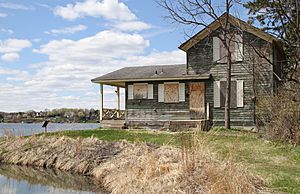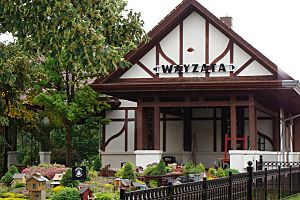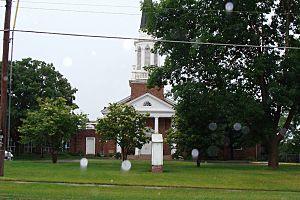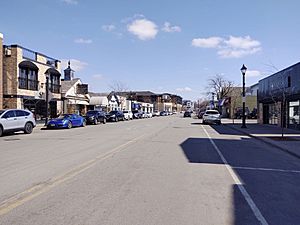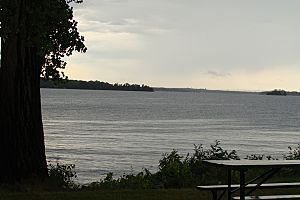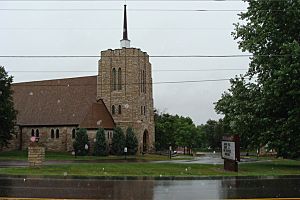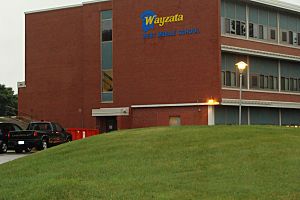Wayzata, Minnesota facts for kids
Quick facts for kids
Wayzata
|
||
|---|---|---|
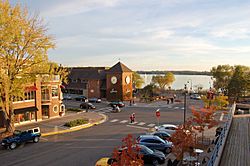
Downtown Wayzata, October 2011
|
||
|
||
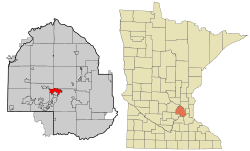
Location of Wayzata
within Hennepin County, Minnesota |
||
| Country | United States | |
| State | Minnesota | |
| County | Hennepin | |
| Founded | 1854 | |
| Incorporated | 1883 | |
| Area | ||
| • Total | 4.70 sq mi (12.16 km2) | |
| • Land | 3.10 sq mi (8.02 km2) | |
| • Water | 1.60 sq mi (4.14 km2) | |
| Elevation | 942 ft (287 m) | |
| Population
(2020)
|
||
| • Total | 4,434 | |
| • Estimate
(2022)
|
4,338 | |
| • Density | 1,431.71/sq mi (552.86/km2) | |
| Time zone | UTC-6 (Central (CST)) | |
| • Summer (DST) | UTC-5 (CDT) | |
| ZIP code |
55391
|
|
| North American Numbering Plan | 952 | |
| FIPS code | 27-68818 | |
| GNIS feature ID | 0653868 | |
Wayzata (pronounced wy-ZET-uh) is a city in Hennepin County, Minnesota, United States. In 2020, about 4,434 people lived there. The city is about 12 miles (19 km) west of Minneapolis. It sits on the northern shore of Lake Minnetonka, which is the ninth largest lake in Minnesota.
Wayzata is often called "The Gateway to Lake Minnetonka." It's known for its many shops and restaurants. People also enjoy outdoor activities there. The Wayzata area is considered one of the wealthiest places in the state.
Contents
Discovering Wayzata's Past
Early Beginnings of Wayzata
The name "Wayzata" comes from the Dakota word wazíyata. This word means "north" or "north shore." The Mdewakanton, a group within the Dakota nation, loved Lake Minnetonka. They called it the "Big Water." It was a special place for hunting, fishing, and gathering wild rice and maple sap. A spot called Spirit Knob in Wayzata Bay was thought to be very sacred.
The Dakota people lived in this part of Minnesota until 1851. That year, the Treaty of Mendota was signed. This treaty opened up land west of the Mississippi River for Euro-American settlers. Most Dakota people were forced to leave Minnesota after 1862.
Oscar E. Garrison first planned out the city of Wayzata in 1854. In 1855, many settlers arrived. They built a sawmill, a hotel, and a blacksmith shop. At first, most settlers cleared the land to grow corn and wheat. In 1857, a grasshopper attack almost ruined their farms. But the community recovered when ginseng was found in the nearby forests. Ginseng root was very popular in China. During this time, Wayzata became a center for collecting ginseng roots from around Lake Minnetonka.
In 1867, the Saint Paul and Pacific Railroad built tracks to Wayzata. This made Wayzata an important transportation center. The railroad was very helpful for local farmers. They could now easily send their crops to markets in Minneapolis, Saint Paul, and other places. The railroad also made Wayzata the main "gateway" to Lake Minnetonka. The lake was promoted as a beautiful and healthy place to visit.
Wayzata's Resort Era
In the 1860s and 1870s, many small hotels and boarding houses were built. They were around Wayzata and Lake Minnetonka to welcome tourists. One early hotel was the Maurer House-West Hotel. It was built near Lake Street and Broadway Avenue. Most hotels were simple until 1879. That's when the large 150-room Hotel Saint Louis was built in Deephaven.
Most tourists in the late 1800s came to Wayzata by train. Steamboats waited for them near Broadway Avenue. These boats took visitors to different spots across the lake. Some steamboats, like the City of Saint Louis and Belle of Minnetonka, were very big. The Belle of Minnetonka was 300 feet (91 m) long. It could carry 2,500 passengers!
Wayzata officially became a village in 1883. One of the first things the village council did was try to move the railroad tracks north of town. James J. Hill, who ran the Saint Paul, Minneapolis, & Manitoba Railway, ignored them at first. When the council took him to court, Hill got angry. He tore down the train station in Wayzata. He built a new one east of town at a stop called "Holdridge." He told Wayzata residents they could "walk a mile for the next twenty years" to catch the train. Hill also moved the tracks, but closer to the lake, not north of town.
Hill was also connected to Wayzata through hotels. His railway owned the Arlington Hotel, Hotel Lafayette, and the Belle of Minnetonka. He bought Wayzata's Arlington Hotel in 1881 but never reopened it. By the 1890s, Lake Minnetonka was less popular for wealthy tourists. New railroad regulations, other vacation spots, and an economic downturn all contributed to this decline.
The Cottage Period in Wayzata
As tourism to Lake Minnetonka slowed in the 1890s, a new time began for Wayzata. As the Twin Cities grew, many city people started building summer cottages along Lake Minnetonka's shores. Some of these new cottages were simple, but others were huge. Wayzata became home to many grand country estates along the Ferndale Shore. Famous families like the Bells, Boveys, Crosbys, Peaveys, Pillsburys, and Washburns built homes there.
Even with new summer homes, Wayzata didn't grow much at first. That changed in 1905. The village council voted to improve relations with Hill and his railway (now called the "Great Northern"). Hill responded by building a new train depot near downtown Wayzata. At its grand opening in 1906, he said it was the "handsomest" station on the entire Great Northern line.
Wayzata also got a new type of water transportation in 1906. The Twin City Rapid Transit Company launched six "Express Boats" on Lake Minnetonka. These boats were like an extension of the Twin City streetcar system. This service stopped in 1926 because fewer people were using it. Some of the Express Boats were purposely sunk in the lake that year. One boat, the Minnehaha, was brought up from the lake in 1980. It was fixed up and started carrying passengers again in 1996.
As the cottage era continued, downtown Wayzata grew with homes and small shops. By 1920, Motorboating was very popular. Wayzata was a key place for this trend. Two famous boat makers, Ramaley and Wise, were based there. In 1929, Ramaley Boat Company joined with Wise Boat Works and Walker Boat Works. They formed Minnetonka Boat Works. This company became well-known for making and selling Tonka-Craft and Chris-Craft power boats.
Wayzata in the 20th Century
Wayzata's population almost doubled before World War II. The city was lucky to have Mayor Rufus Rand. He helped the town update its services. Under Rand, every building got water and sewer service. Streetlights were put in, roads were paved, and a public beach and park were opened.
After World War II, many local farms and summer cottages became year-round single-family homes. Many new homes and gas stations were also built. U.S. Highway 12, built in the 1920s, was made wider to four lanes. The population grew a lot. Downtown Wayzata homes were replaced by more stores. These stores served Wayzata residents and new families moving to the former farmlands outside the city. By the 1950s, the larger Minneapolis-Saint Paul area had reached Wayzata.
After becoming a charter city, Wayzata started adding land from Minnetonka, Plymouth, and Orono. The city doubled in size. U.S. Highway 12 was made even wider to become a freeway in the 1970s. A new shopping center opened 5 miles (8 km) down the road. These changes meant some downtown Wayzata shops were replaced by apartments and office buildings. Strip malls and fast food places appeared near the highway.
Wayzata's Location and Environment
Where is Wayzata Located?
Wayzata is a suburb of Minneapolis, Minnesota. It is about 9 miles (14 km) west of Minneapolis. The city is on the northeast tip of Lake Minnetonka. The United States Census Bureau says the city covers 3.16 square miles (8.18 km2). Of this, 3.08 square miles (7.98 km2) is land and 0.08 square miles (0.21 km2) is water.
The main types of land in Wayzata are:
- Open water (36%)
- Residential areas, farms, and commercial lands (35%)
- Forest (13%)
- Farms (8%)
Wayzata's Climate
Wayzata has a humid continental climate. This means it has hot summers, cold winters, and mild autumns and springs.
- Average summer temperatures are from 56 to 82 degrees Fahrenheit (13 to 28 degrees Celsius).
- Average winter temperatures are from 2 to 27 degrees Fahrenheit (-17 to -3 degrees Celsius).
- The average yearly rainfall is 30.4 inches (77.2 cm).
- The average yearly snowfall is 54.4 inches (138 cm).
Plants and Animals in Wayzata
Before Euro-Americans settled the area, Wayzata was mostly "upland deciduous forest, with small areas of wet prairie, and lakes." The forests in Wayzata used to have "maple-basswood forest, oak forest, lowland hardwood forest, and floodplain forest."
Today, some non-native forest types are found. These are mostly disturbed forests with elm, box elder, ash, and cottonwood. You might also see basswood, maple, and oak.
Some plants that are considered invasive in Wayzata are:
- purple loosestrife
- narrow-leaf cattail
- common buckthorn
- leafy spurge
- tartarian honeysuckle
- garlic mustard
- reed canary grass
- Siberian elm
- Amur maple
Some rare native animals have also been seen in Wayzata. These include the Acadian flycatcher, pugnose shiner, and red-shouldered hawk.
Wayzata's Population and People
| Historical population | |||
|---|---|---|---|
| Census | Pop. | %± | |
| 1880 | 132 | — | |
| 1890 | 273 | 106.8% | |
| 1900 | 276 | 1.1% | |
| 1910 | 492 | 78.3% | |
| 1920 | 633 | 28.7% | |
| 1930 | 1,100 | 73.8% | |
| 1940 | 1,473 | 33.9% | |
| 1950 | 1,791 | 21.6% | |
| 1960 | 3,219 | 79.7% | |
| 1970 | 3,700 | 14.9% | |
| 1980 | 3,621 | −2.1% | |
| 1990 | 3,806 | 5.1% | |
| 2000 | 4,113 | 8.1% | |
| 2010 | 3,688 | −10.3% | |
| 2020 | 4,434 | 20.2% | |
| 2022 (est.) | 4,338 | 17.6% | |
| U.S. Decennial Census 2020 Census |
|||
Who Lives in Wayzata? (2010 Census)
In 2010, a census showed there were 3,688 people living in Wayzata. There were 1,795 households and 944 families. The population density was about 1,197.4 people per square mile (462.3 per km2). There were 2,041 housing units.
Here's a look at the different groups of people in Wayzata:
- 92.5% White
- 3.0% African American
- 0.4% Native American
- 1.3% Asian
- 0.1% Pacific Islander
- 1.5% from other races
- 1.1% from two or more races
- 3.6% were Hispanic or Latino (of any race).
Of the 1,795 households:
- 20.8% had children under 18.
- 42.3% were married couples living together.
- 7.2% had a female head of household with no husband.
- 3.1% had a male head of household with no wife.
- 47.4% were not families.
- 41.6% of all households were single individuals.
- 18.3% had someone living alone who was 65 or older.
The average household had 2.04 people. The average family had 2.80 people. The median age in the city was 47.8 years.
- 19.1% of residents were under 18.
- 6.3% were between 18 and 24.
- 20.7% were from 25 to 44.
- 31.9% were from 45 to 64.
- 22.2% were 65 or older.
Among residents, 47.5% were male and 52.5% were female.
Wayzata's Economy
Major Companies in Wayzata
The main offices for Cargill and Carlson are in Minnetonka. They are less than 1 mile (1.6 km) from Wayzata. These two companies are some of the biggest employers in the Wayzata area.
The regional bank TCF started in Wayzata in 1923. Its main office was in Wayzata until 2019. Northern Oil and Gas, Inc. and Ace Casual Furniture also have their main offices in Wayzata.
Wayzata's Infrastructure
The United States Postal Service has a post office in Wayzata. Its ZIP code is 55391. This ZIP code covers a much larger area than just Wayzata. It includes seven other towns around eastern Lake Minnetonka. All places in this ZIP code use "Wayzata" in their mailing address. The BNSF Railway also serves Wayzata.
Education in Wayzata
Wayzata Public Schools are part of Independent School District (ISD) 284. They serve all or parts of eight western suburbs. These include Plymouth, Corcoran, Hamel, Maple Grove, Medicine Lake, Medina, Minnetonka, and Orono.
The only school actually inside Wayzata's city limits is West Middle School. The school district covers 38 square miles (98 km2). It stretches north and east from Wayzata Bay on Lake Minnetonka. It is about 8 miles (13 km) west of Minneapolis.
About 9,510 students attend schools in the district. There are:
- Eight public elementary schools (Kindergarten to 5th grade)
- Three middle schools (6th to 8th grade)
- One high school (9th to 12th grade)
Some students in the area go to public schools in other districts. This is allowed under Minnesota's open enrollment law. In 2012, Newsweek magazine named Wayzata High School one of the top 1,000 public high schools in the United States.
| Schools in the Wayzata School District | ||
|---|---|---|
| Elementary schools | Middle schools | High School |
| Sunset Hill | West Middle School | Wayzata High School |
| Plymouth Creek | Central Middle School | |
| Oakwood | East Middle School | |
| Meadow Ridge | ||
| Kimberly Lane | ||
| Greenwood | ||
| Gleason Lake | ||
| Birchview | ||
| North Woods | ||
Parks and Fun in Wayzata
Dakota Rail Regional Trail
The Dakota Rail Trail is a paved path that is 13.5 miles (21.7 km) long. In Hennepin County, the trail goes around Lake Minnetonka. It passes through Wayzata, Orono, Minnetonka Beach, Spring Park, Mound, Minnetrista, and Saint Bonifacius. The trail continues for another 12.5 miles (20.1 km) in Carver County. It ends in Mayer. The Three River Park District manages the trail.
Wayzata Beach
Wayzata Beach is in downtown Wayzata on Lake Minnetonka. The beach is open to everyone. You can park there with a permit or pay for parking. A lifeguard is on duty from mid-June to mid-August if the temperature is above 65 degrees Fahrenheit (18 degrees Celsius).
The beach has:
- A sandy beach and a grassy area
- Shaded picnic spots
- Playground equipment
- Places to store canoes
- Stand-up paddleboard rentals
- A volleyball court
- Boat slips
- Playing fields
Famous People from Wayzata
- Salisbury Adams, Minnesota state lawmaker and lawyer
- James Ford Bell, first president of General Mills
- Al Quie, former Governor of Minnesota and U.S. Congressman
- Rufus Rand, politician and business leader
- Douglas Dayton, first president of Target
- Marchette Chute, U.S. author and biographer
- Eugene Larkin, Artist, printmaker, lithographer
- Dick Beardsley, long-distance runner and winner of the 1981 London Marathon
- Kent DuChaine, American blues singer and guitarist
- Kimberly Elise, film and television actress (graduated from Wayzata Senior High)
- Orlando J. Heinitz, politician and businessman
- Tim Herron, American professional golfer
- James Laurinaitis, linebacker for the Saint Louis Rams
- Lorie Line, pianist
- David Bromstad, designer and television personality
- Jim Ramstad, U.S. Representative
- Betsy Hodges, Mayor of Minneapolis from 2014 to 2018
- Amy Klobuchar, U.S. Senator (graduated from Wayzata Senior High)
- Robert L. Searles, Minnesota state representative and businessman
Images for kids
See also
 In Spanish: Wayzata (Minnesota) para niños
In Spanish: Wayzata (Minnesota) para niños



